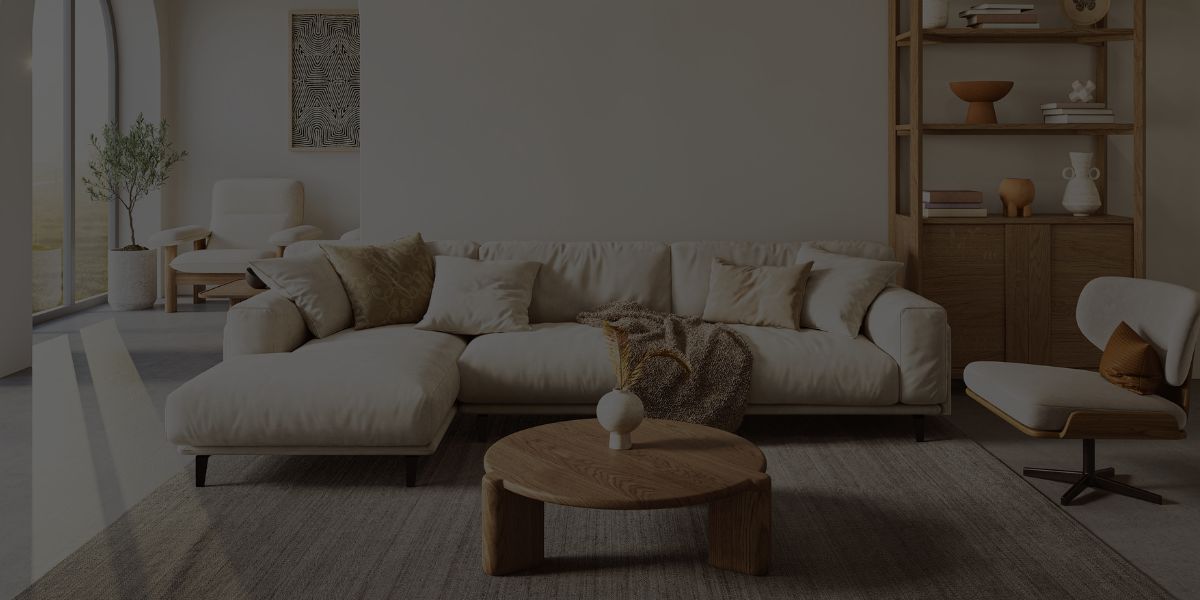Interior Design Portfolio Example: Key Points
- A portfolio is your brand, not just projects.
- Show 6–10 strong works, not everything.
- Tell stories with sketches, photos, and results.
- Use multiple formats: PDF, website, and print.
- Update often and tailor for each opportunity.
Introduction
Every aspiring and professional interior designer needs more than talent. They need a portfolio that captures attention, tells a story, and proves their value! An interior design portfolio is often your first impression with clients, employers, and schools. It’s also one of the most powerful career tools you’ll ever create.
Keep reading to discover the ultimate interior design portfolio example guide, complete with templates, strategies, and inspiration to help you stand out!
Meet Niki Panagiotopoulos, Interior Designer & Home Stager
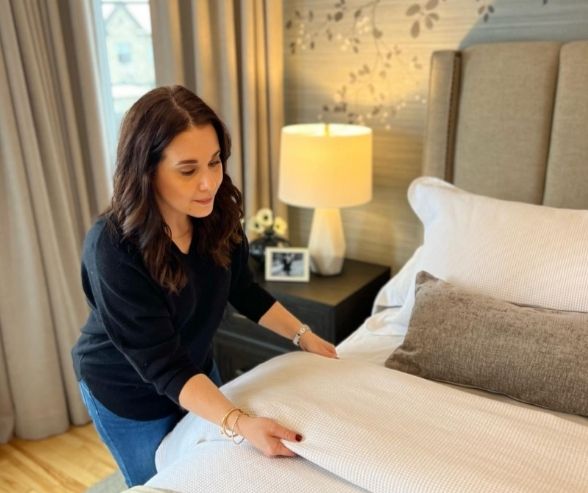
Photo by Helen Kritikakos.
From a young age, Niki Panagiotopoulos loved design, collecting magazine clippings to build her “dream home.” Though she first pursued Literature with plans for law, she soon followed her true passion and graduated in 2005 from QC Design School’s Interior Decorating program and Home Staging Workshop. She later returned as a tutor, mentoring future designers.
That same year, Niki founded Wish Decor Interior Design, where she focuses on residential projects. She offers full-service renovations, furnishings, and design packages that give clients creative direction without full-service commitment. For Niki, the most rewarding part is earning her clients’ trust and creating homes they’ll cherish for years.
Fun fact: before running her business full-time, Niki also coached competitive figure skating, balancing both careers for 10 years while building her portfolio.
An interior design portfolio is more than a showcase of your work. It’s proof of your talent, dedication, and growth as a designer. Whether you’re applying to school, pitching a freelance project, or interviewing for a job, people will look at your portfolio before deciding to hire or accept you.
Here’s why it matters so much:
- First impressions count. According to UX Collective, most people spend less than three minutes reviewing portfolios.
- It shows your thinking. They want to see how you solve problems, not just the final results.
- A high-quality portfolio builds credibility. A polished portfolio makes you look professional and prepared.
- It highlights your niche. Employers and clients can quickly see if your skills match their needs.
- Moreover, it tells your story. A portfolio gives people insight into your style, personality, and process.
Think of an interior design portfolio as a visual resume combined with a personal brand showcase. Done well, it sets you apart instantly!
Essential Elements Every Portfolio Needs
Not sure where to start? Every strong portfolio shares some key elements:
Quality Over Quantity
For starters, keep in mind that less is more. Six to ten excellent projects are stronger than twenty average ones. So, choose work that reflects your best skills and range. Each project should:
- Be polished and professional.
- Represent your style and vision.
- Show growth over time.
Tailor Your Content
The reality is, generic portfolios don’t win opportunities. The easiest way to ensure you don’t fall into this trap is to make sure your portfolio fits your audience.
- Residential design: kitchens, living rooms, remodels.
- Commercial design: offices, restaurants, retail.
- Hospitality design: hotels, spas, lounges.
And if you’re applying to multiple areas? Create different versions of your portfolio.
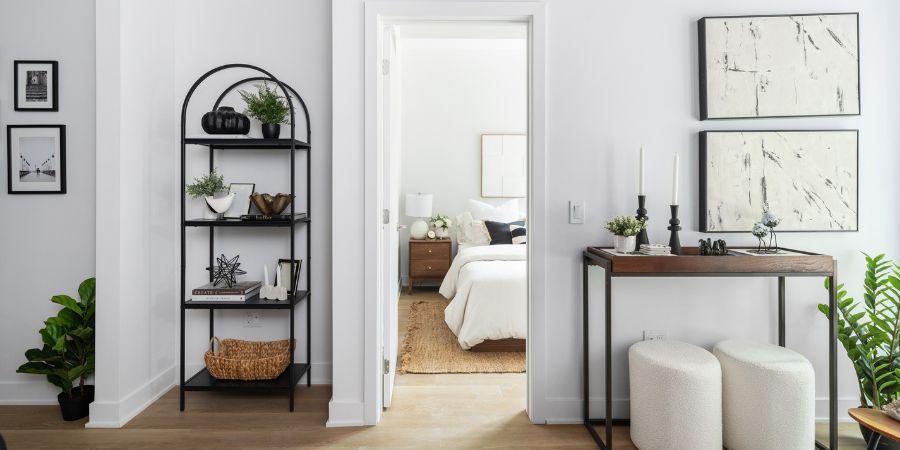
Photo by Corey Kaminski of MTL Interiors.
Visual Storytelling
A good portfolio tells a story through images and layout. Therefore, it’s a good idea to include:
- High-quality, well-lit photos.
- Mood boards and inspiration.
- Sketches and renderings.
- Before-and-after transformations.
The more you show your process, the more memorable your work becomes.
Multiple Formats
Clients and employers expect options. Consider creating a:
- Digital portfolio website that can be viewed anywhere.
- PDF interior design portfolio example that you can email.
- Printed version for interviews or presentations.
Having all three shows professionalism and flexibility!
Interior Design Portfolio Example for Inspiration
Examples help bring ideas to life. Here’s what to look for:
- Successful portfolios are clean, organized, and easy to navigate. They use consistent branding and balance images with concise text.
- Student portfolios often highlight academic projects, but they can be just as impactful as professional ones if presented well.
- Professional portfolios may include larger-scale projects, but they still showcase sketches, notes, and problem-solving steps.
Signs of a Strong Portfolio Example
- Includes 6–10 carefully chosen projects.
- Uses before-and-after images to tell a story.
- Includes process materials like mood boards.
- Offers a clean, consistent design style.
- Features a clear personal brand (logo, fonts, colors).
Signs of a Weak Portfolio Example
- Overloaded with too many projects.
- Uses poor-quality photos.
- Missing clear descriptions or captions.
- Layout feels cluttered and inconsistent.
- Doesn’t provide easy ways to contact the designer.
Showcasing Niki’s Portfolio: A Real Example of Strong Interior Design Work
A great design portfolio doesn’t just display pretty rooms—it tells a complete story. In this example, we’ll look at two images from the same project: a master bedroom and adjoining ensuite bathroom designed by Niki. Together, they highlight how thoughtful design choices can create harmony across connected spaces.
Along with each photo, you’ll also see Niki’s commentary, offering insight into her creative process and the details that brought her vision to life!
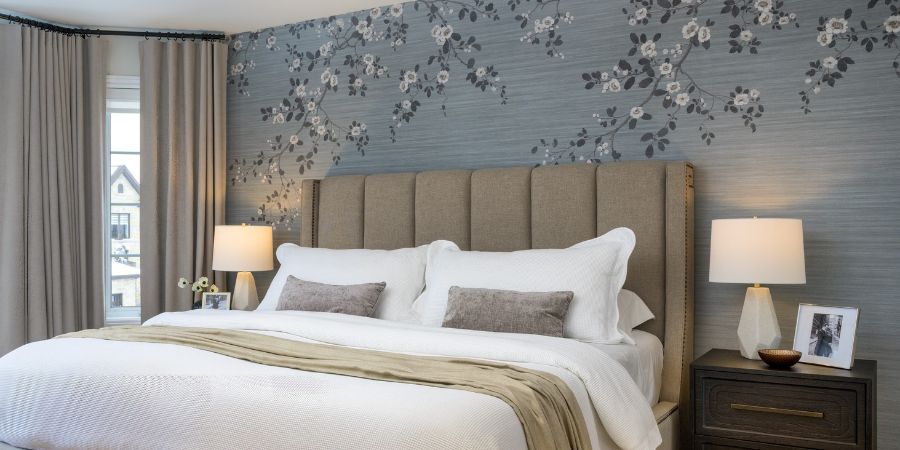
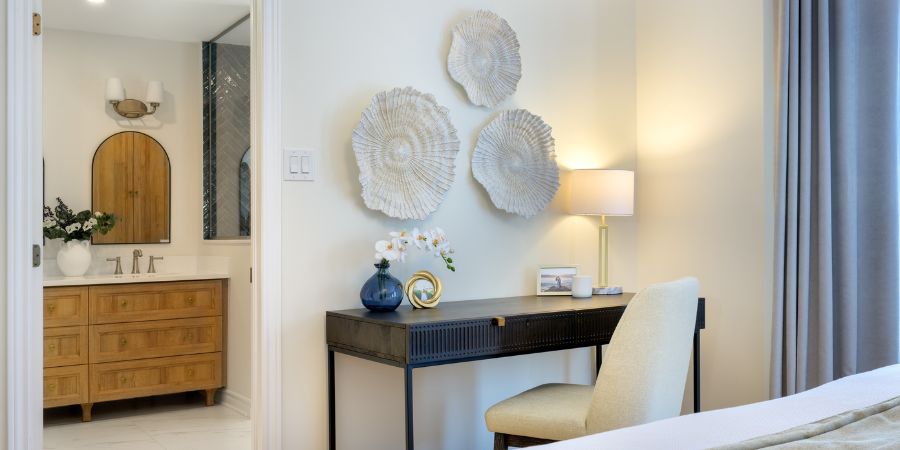
Photos by Telly Goumas.
“This master bedroom represents a full-scale transformation. The only element the client wished to keep was the bed, allowing us to design every other detail from a clean canvas. I selected this project because it exemplifies the level of thought, detail, and care we bring to our full-service design process. Furthermore, it showcases our ability to create deeply personalized, layered spaces.
In this room, we see layers of texture, pattern, and color working together in harmony to create a warm, tranquil retreat inspired by nature and the seaside (two themes that deeply influence my own work). Being an author, the client envisioned a quiet, restorative space to write. From the handpicked wallpaper and soft bedding to the cohesive color palette with all the soft furnishings, custom drapery, and the delicate seashell accents above her desk, every detail reflects her aspirations and our commitment to creating spaces that feel both personal and inspiring.”
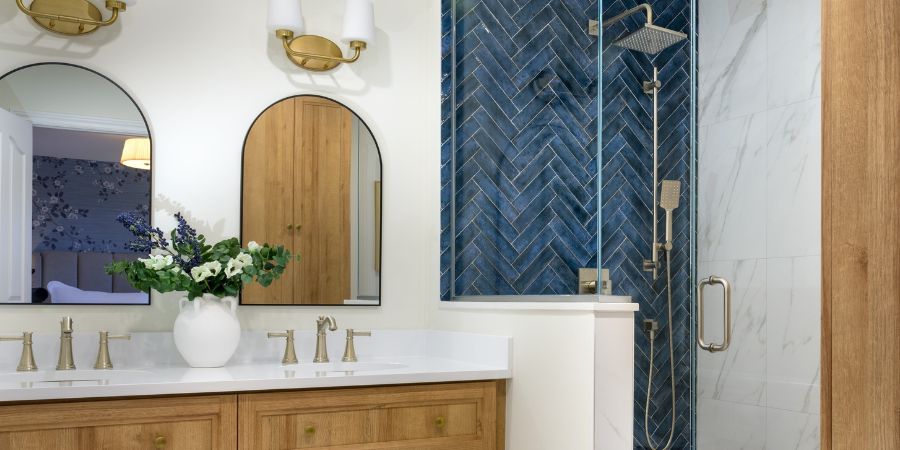
Photo by Telly Goumas.
“The adjoining ensuite bathroom continues the story of this retreat, illustrating my ability to select materials that not only complement each other but also reflect the environment around them, creating a seamless flow between spaces. Many elements, including the vanity and shower, were custom designed. As such, they highlight the level of detail and expertise we bring to each project.”
Become an Interior Designer
Perfect your interior design portfolio + book your first client in as little as 3 months!
Step-by-Step Guide: How to Make an Interior Design Portfolio
Creating a portfolio can feel like a big project, especially when you’re first starting out. The good news is that with the right structure, anyone can do it! Below you’ll find a simple, step-by-step process that works for students, career changers, and professionals.
Step 1: Define Your Goal and Audience
Firstly, before you start designing pages, you need to know who will be looking at your portfolio. After all, your audience and your career goals will shape the format, style, and content of your work.
TIPS
- Pick one main goal: school admission, first job, new clients, or career change.
- List your audience: recruiter, principal designer, homeowner, developer.
- Write a one-sentence aim: “Show 6 projects that prove I can plan small kitchens.”
- Choose a tone: friendly for residential, expert for commercial.
- Keep a short checklist on your desk to guide every choice.
Step 2: Audit and Gather Your Work
Next, every great interior design portfolio example begins with a collection of raw materials. Thus, before you can curate, you first need to gather.
TIPS
- Collect school studios, freelance jobs, internships, passion projects.
- Pull sketches, floor plans, renderings, photos, and notes.
- Save files in folders by project.
- Keep only work you can explain with pride.
- Write a one-line summary for each project.
Step 3: Choose Your Top 6–10 Projects With a Simple Score
Now remember: you don’t need to show everything. In fact, the strongest interior design student portfolio examples are selective. For this reason, we recommend using a scoring method to decide what stays and what goes.
Score each project 1–5 for:
- Visual impact
- Craft/detail
- Variety (typology, size, style)
- Process (sketches to results)
- Relevance to your goal
Pick the highest totals, and drop the rest.
Step 4: No Experience? Create Smart Projects Fast
Not everyone has client projects to show. Don’t worry! You can still build a strong interior designer portfolio. Employers and clients want to see your process, not just paid work.
TIPS
- Redesign a room in your home.
- Do a pro-bono or low-stakes project for a friend.
- Take part in a stylized photoshoot with other industry professionals in your area.
- Build a concept project from a real brief you find online.
- Re-work a studio project to a higher standard.
- Show the full process: mood board → plan → render → photos.
Not sure what goes into a mood board? This guide breaks down everything you need to know!
Step 5: Plan the Story for Each Project
Your projects aren’t just pictures, they’re stories! Thus, the best interior design portfolio templates use a consistent narrative style to guide the reader.
Use this 5-part script for every case study:
- Client/Context (who/where)
- Goal (what they needed)
- Challenge (budget, space, deadline)
- Solution (your key moves)
- Result (metrics, quote, photo)
We recommend keeping it short (120–200 words per project).
Showcasing Niki’s Portfolio: Another Example of Professional Interior Design
To bring this idea to life, we’ll now look at another project from Niki’s portfolio, again with her own commentary. She’ll walk us through the story of the space, from the client’s needs to the challenges, solutions, and final results. This way, you’ll see how a strong portfolio blends visuals with narrative to show both the design process and the finished work!
Storytelling Through Your Interior Design Portfolio
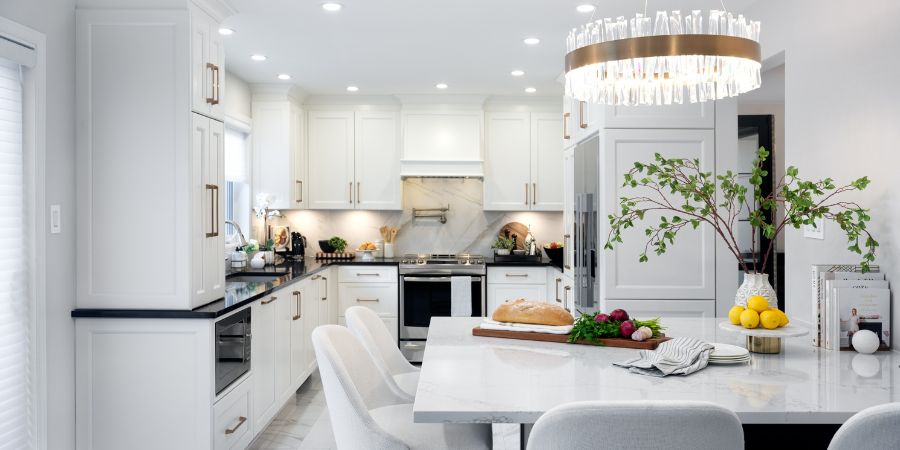
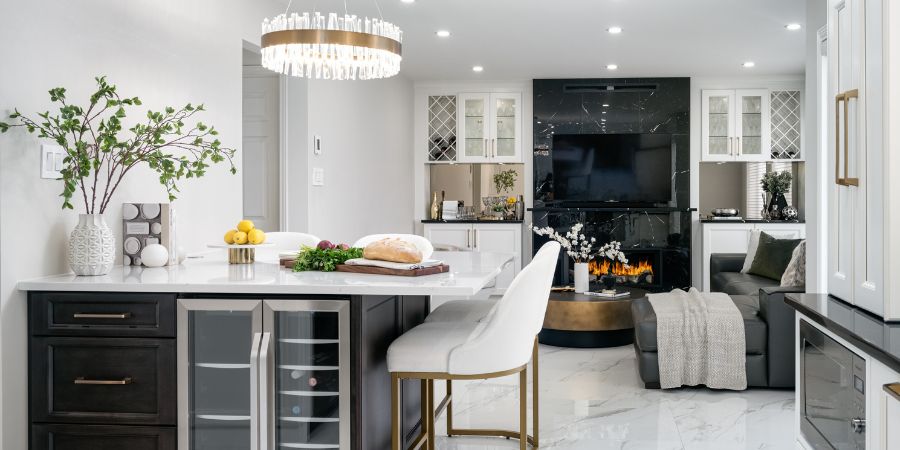
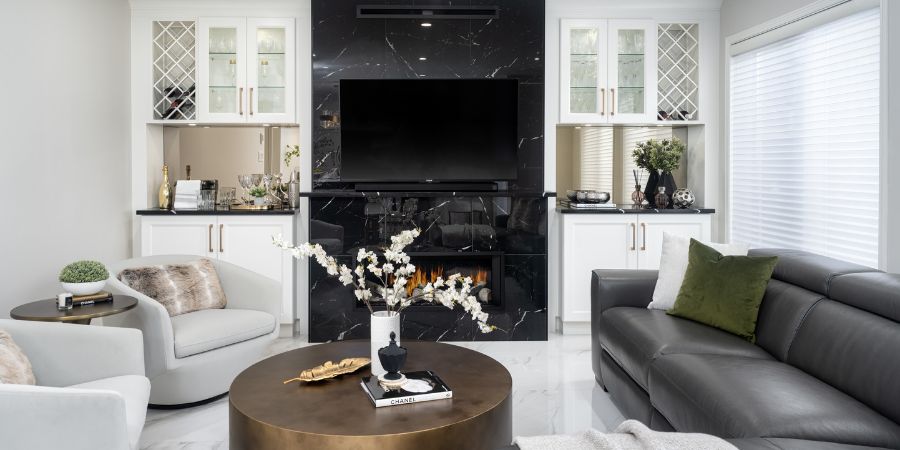
Photos by Telly Goumas.
“One client asked for a kitchen and family room renovation. The kitchen had gorgeous floor-to-ceiling windows, but the layout lacked storage and prep space. We preserved the light and view the client loved, but replaced the windows with shorter, narrower ones. This gave us room for a full run of lower cabinetry, additional uppers, and a generous peninsula. The client originally wanted an island, but our solution offered better flow, more storage, and a seamless connection to the family room.
In the family room, an awkward angled fireplace limited furniture placement and didn’t serve as a strong focal point. We moved the fireplace to the back wall, flanked it with built-ins, and created a seating plan that finally made sense. The result was a cohesive, functional space that checked every box—and the clients were thrilled.
Your process is just as important as the finished photos. Clients want to see how you’ll bring their vision to life. Use your portfolio to show the thinking behind your choices—like moodboards, sketches, or floor plans—and then pair them with professional photos. That context elevates your work from “pretty pictures” to meaningful stories.”
Step 6: Set Clear Image Standards
Images are the first thing people notice, and poor-quality visuals can ruin even the best design work. This is why every PDF interior design portfolio example should abide by the following image rules:
- Use bright, sharp, well-cropped images.
- Export web images around 1600–2000px wide.
- Print images at 300 dpi.
- Avoid heavy filters; keep colors true.
- Add 1–2 before/after pairs per project.
Step 7: Build Your Layout With a Template and Grid
The layout of your portfolio is what makes your work look professional. Whether you use Canva, Adobe InDesign, or a free interior design portfolio template, grids will ALWAYS be your friend!
TIPS
- Use a 12-column grid with generous margins.
- Pick two fonts: one for headings, one for body text.
- Keep headings short; use action words.
- Repeat a fixed project header: Title · Type · Role · Year.
- Create one master page, then duplicate for speed.
Step 8: Write Captions That Add Value
Captions turn images into lessons. They explain what you did and why it matters. This is what separates a pretty portfolio from a powerful one.
TIPS
- 1-line caption above each image: what to notice and why it matters.
- Use plain words: “New plan adds storage and light.”
- Add labels on drawings: scale, north arrow, materials.
- Keep paragraphs short (2–3 sentences).
- Use bullets for specs and outcomes.
Step 9: Assemble a Polished PDF
Even in a digital world, employers and clients still often ask for a PDF. This is because a PDF interior design portfolio example is easy to send, print, and archive.
TIPS
- 15–30 pages in length.
- Add a clickable table of contents.
- Keep file size under ~10 MB for email.
- Name it clearly: Firstname_Lastname_Portfolio.pdf.
- Export a high-res print version and a web version.
Step 10: Build an Interior Design Portfolio Website
In this day and age, a professional website is your 24/7 business card. Think about it: an interior design portfolio website not only looks professional but also makes you discoverable on Google. Basically, you need to have one if you want to be successful!
TIPS
- Platforms: Squarespace, Wix, WordPress, Webflow, Behance.
- Pages: Home, About, Portfolio (project pages), Services, Contact.
- Each project page = your 5-part script + gallery.
- Add a simple contact form and email link.
- Include basic SEO: title tags, meta descriptions, alt text with natural keywords.
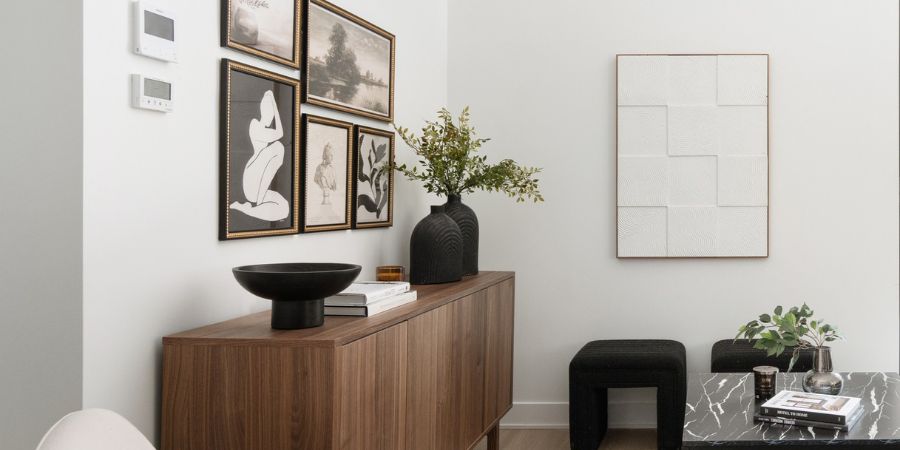
Photo by Corey Kaminski of MTL Interiors.
Step 11: Add Personal Branding and Contact Info
Along the way, don’t forget that your portfolio should always look and feel like YOU. Branding is what makes you memorable, whether you’re sharing a PDF or website.
TIPS
- Pick a color palette and stick to it.
- Add a small logo or monogram.
- Use the same headshot across PDF and site.
- Write a 60–90 word bio with your focus and location.
- Place contact info on every page footer and the final page.
Step 12: Add Proof: Testimonials, Metrics, and Awards
People trust results. By adding proof to your portfolio, you show that your work has real impact!
Ways to add proof to your interior design portfolio example:
- Short client quotes (1–2 sentences).
- Simple numbers: budget met, time saved, sales lift, square footage improved.
- List press, awards, or exhibitions.
- Cite collaborators when needed.
- Add one line on your role in team projects.
Step 13: Check UX and Accessibility
Good design is about usability, and that applies to your portfolio too. Therefore, make sure both your PDF and website are always easy to navigate and accessible to all readers.
TIPS
- Use 12–16 pt body text for readability.
- Maintain strong color contrast for text.
- Add alt text to all images on your site.
- Test the PDF on phone, tablet, and laptop.
- Make sure links and buttons are clear and large enough.
Step 14: Tailor Versions for Each Opportunity
When it comes to interior design portfolios, a one-size-fits-all approach doesn’t work. To stand out, you need to create different versions of your portfolio for different audiences.
TIPS
- Create a master portfolio with all projects.
- Duplicate and cherry-pick 6–10 projects for each application.
- Reorder projects to match the firm’s focus.
- Rename the PDF for the job: Lastname_Portfolio_FirmName.pdf.
- Add one custom line on your cover about fit.
Step 15: Practice Your Portfolio Presentation
Next, how you present your work matters just as much as the work itself. Therefore, be ready to talk through your projects with confidence.
TIPS
- Rehearse a 5–7 minute walk-through.
- Use the 5-part script out loud for each project.
- Practice screen-sharing on Zoom/Meet.
- Prepare quick answers about budget, codes, and materials.
- Keep a one-page leave-behind or link ready.
Step 16: Publish, Share, and Track
Ultimately, an interior design portfolio example only works if people actually see it. So make sure to share it widely, and track where it goes!
TIPS
- Post your site and 1–2 projects on social media platforms like LinkedIn and Instagram.
- Add your link to email signature and business cards.
- Submit to design directories and student showcases.
- Keep a simple tracker of who you sent it to and when.
- Set a 6-month calendar reminder to update both PDF and site.
Step 17: Create a Mini “Teaser” and a Deep “Master” Version
Here’s the thing: different contexts need different versions. For instance, a recruiter may want something quick, whereas a hiring manager may want more detail.
TIPS
- Teaser PDF (6–8 pages) for cold emails and quick screenings.
- Master PDF (15–30 pages) for serious reviews.
- Website for the full library and SEO.
- Keep the visual style consistent across all three.
- Always link from teaser → website for more.
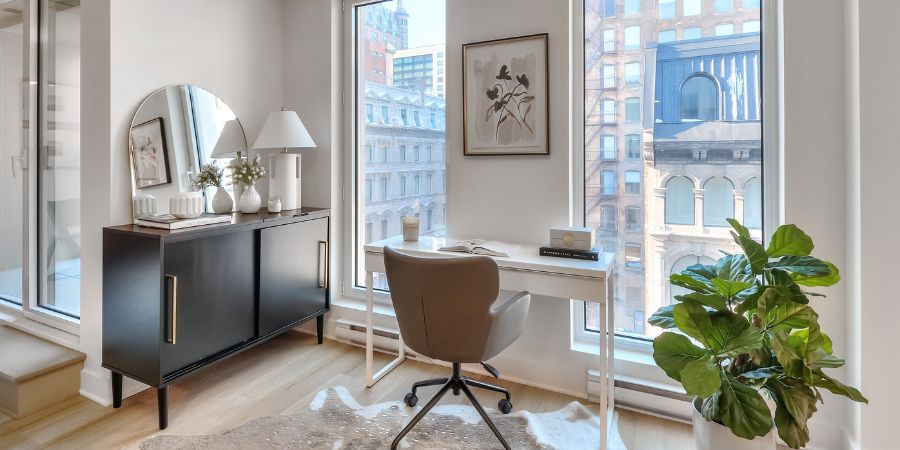
Photo by Corey Kaminski of MTL Interiors.
Step 18: Add a Simple Services Sheet (For Freelancers)
If you’re freelancing, your portfolio should do more than impress—it should SELL. Adding a services sheet makes it clear what you offer.
TIPS
- List 3–5 services in plain language.
- Add basic process steps and timelines.
- Include a starting price range if you wish.
- Place this as a separate PDF or site page.
- Link it from your portfolio’s last page.
Step 19: Create a Quick-Update Workflow
The best portfolios are living documents that get updated/revised on a regular basis. Thus, set up a system so updates are easy!
TIPS
- Keep a “New Work” folder on your desktop.
- Drop new images and notes in as you go.
- Set a monthly 30-minute slot to tidy that folder.
- Every 6 months, refresh your PDF and site.
- Archive older projects to keep things tight.
Step 20: Final Pre-Send Checklist
Before you hit send, do one last check. A mistake-free portfolio shows professionalism.
TIPS
- Spelling, alignment, and consistent margins.
- All links and emails work.
- File size < ~10 MB for the web PDF.
- Clear file name and cover.
- Contact info on the last page and footer.
Build a Design Portfolio That Gets You Noticed
Learn to create a polished, professional design portfolio that showcases your talent and attracts dream clients!
Portfolio Formats: Digital, PDF, and Print Compared
Different formats work best in different situations. Consider the following:
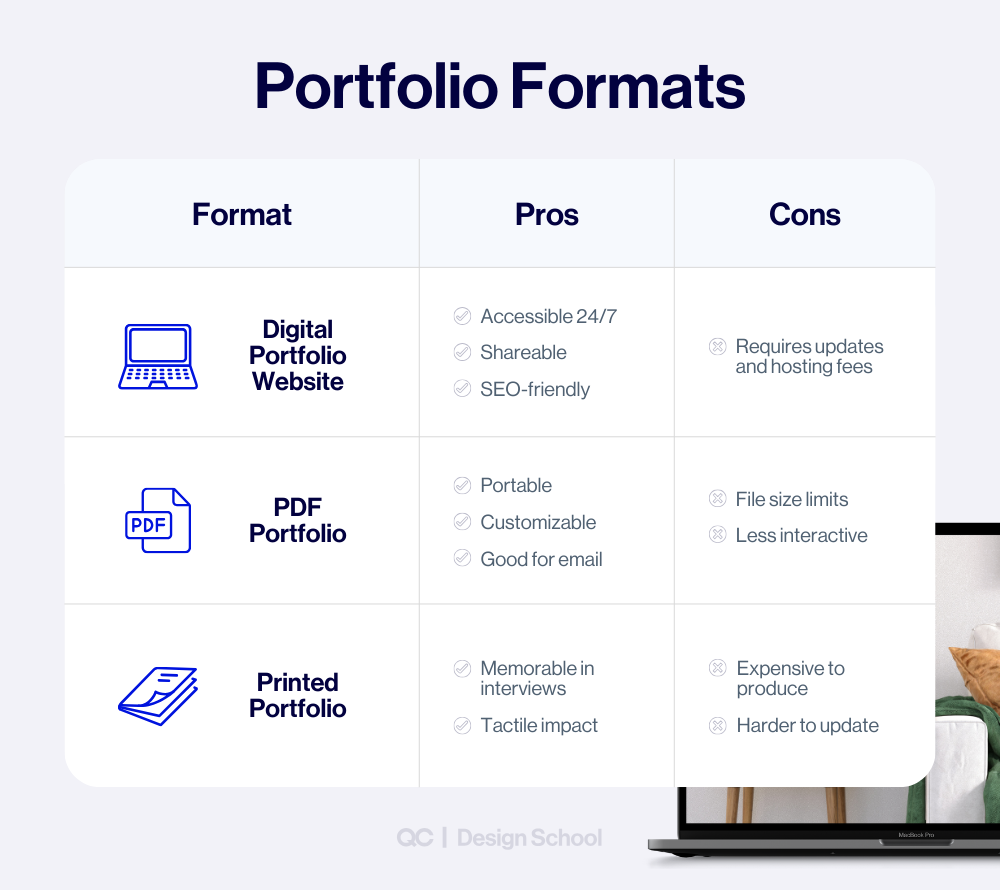
Showcasing Your Design Process (Not Just the Final Product)
Clients and employers want to see how you think. So, when showcasing your design process, ensure to include:
- Mood boards and color palettes.
- Early sketches and space planning diagrams.
- Work-in-progress renderings.
- Before-and-after comparisons.
Moreover, add measurable outcomes when possible. Here are a couple examples to give you an idea of what we mean:
- “Redesign increased sales by 18%.”
- “Improved workspace flow for 30 employees.”
Testimonials from clients, past employers, and/or school instructors also add extra credibility, too.
Advanced Enhancements to Elevate Your Portfolio
From here, you can take your portfolio even further with the following upgrades:
- Interactive elements – 360 tours, videos, animations.
- Detailed case studies – Full walkthroughs of select projects.
- Personal branding – Use your logo, fonts, and color scheme.
- Consistency – Align your portfolio with your resume, website, and social media.
These touches help your portfolio feel polished and professional.
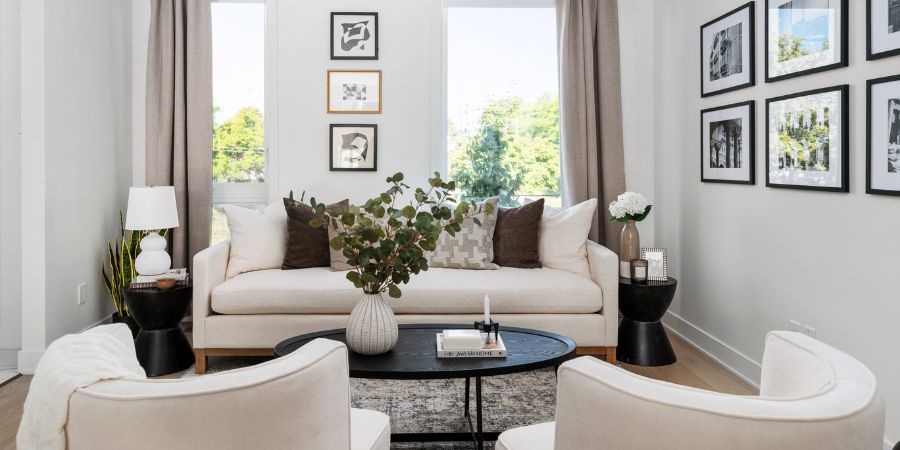
Photo by Corey Kaminski of MTL Interiors.
Common Mistakes to Avoid in Your Portfolio
Many designers lose opportunities because of simple mistakes.
In addition to Niki’s advice, make sure to also watch out for:
- Missing contact info or bio.
- Outdated content.
- Cluttered, confusing layouts.
And don’t forget to update your portfolio at least every six months! Remove old work and add fresh projects.
Tools, Templates, and Resources for Building Your Portfolio
The right tools save time and help your portfolio look professional. Whether you’re creating a PDF interior design portfolio or an online portfolio website, these popular platforms make the process easier and more polished.
Design Software:
- Adobe InDesign: Perfect for creating sleek, print-ready layouts.
- Canva: User-friendly templates for beginners and professionals alike.
- Photoshop: Great for editing and enhancing project images.
- Figma: Ideal for digital mockups and interface presentations.
- SketchUp: Excellent for producing 3D floor plans and renderings.
Online Platforms:
- Behance: Showcase and network with other design professionals.
- Wix: Quick drag-and-drop website builder for stylish portfolios.
- Squarespace: Clean, modern templates tailored to creative industries.
- WordPress: Highly customizable for experienced users.
- Issuu: Best for hosting and sharing PDF portfolios online.
Resources:
- Free and paid portfolio templates to help you get started fast.
- QC Design School’s blog for portfolio inspiration, feedback tips, and design insights.
- QC’s online Virtual Design Training Course—an interactive, hands-on learning experience that teaches you how to work with remote clients, create professional digital presentations, and showcase your portfolio virtually.
Whether you’re designing for print, web, or virtual spaces, these tools—combined with QC’s professional training—give you everything you need to create a standout interior designer portfolio that looks polished and professional.
Expert Tips from Industry Professionals
Industry experts agree: portfolios don’t need to be perfect, but they DO need to show effort and thought.
Key Tips for Your Interior Design Portfolio
- Focus on clarity and curation.
- Show your design process, not just results.
- Add context to each project.
- Let your unique style shine through.
- Practice presenting your portfolio out loud.
Conclusion: Build Your Future with QC Design School
A portfolio is more than a collection of projects—it’s your personal brand! It tells the world who you are as a designer, how you think, and why you’re the right choice. By combining strong visuals, storytelling, and a polished layout, you’ll create a portfolio that wins opportunities.
Take the Next Step with QC Design School
If you’re serious about building a career in interior design, you’re going to need training, guidance, and feedback from professionals who know the industry. That’s exactly what you’ll find at QC Design School.
QC’s self-paced, online Interior Design & Decorating certification course gives you the knowledge and tools to create a portfolio that employers and clients can’t ignore. In as little as 3 short months, you’ll learn design theory, practical techniques, client communication skills, and business training. Furthermore, you’ll also receive personalized feedback from experienced tutors after every unit of the program.
With QC, you don’t just build a portfolio; you build confidence, credibility, and a clear career path!
”I absolutely recommend QC Design School! They are so supportive. I love that their courses are self-paced and online, so you don’t feel rushed. My training provided me exactly what I needed to be able to succeed with my own business!
Natalie MireaultInternational Staging and Redesign Professional™ (ISRP™) • QC Design School Graduate
Ready to transform your passion for design into a career? Enroll in QC Design School’s Interior Design & Decorating Course today, and take the first step toward a future full of creative opportunities!
FAQs About Interior Design Portfolio Examples
What does an interior design portfolio look like?
It includes project photos, sketches, renderings, and short descriptions. A strong portfolio highlights process and results.
How do I create an interior design portfolio with no experience?
Use academic projects, volunteer work, or personal design experiments. Highlight your process, not just the end product.
What should be included in an interior design portfolio?
Best projects, project context, mood boards, sketches, before-and-after images, and contact details.
How many projects should be in a portfolio?
6-10 strong projects are ideal. Too many can overwhelm viewers.
Should I have both a PDF and an interior design portfolio website?
Yes. A website boosts visibility, and a PDF is easy to email. Both increase opportunities!
What’s the best format for a student interior design portfolio?
Students should start with a PDF or website. Both work well for school applications and entry-level jobs.
How often should I update my interior design portfolio?
At least every 6 months. Remove outdated work and showcase new projects.
